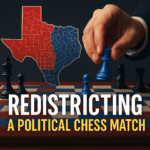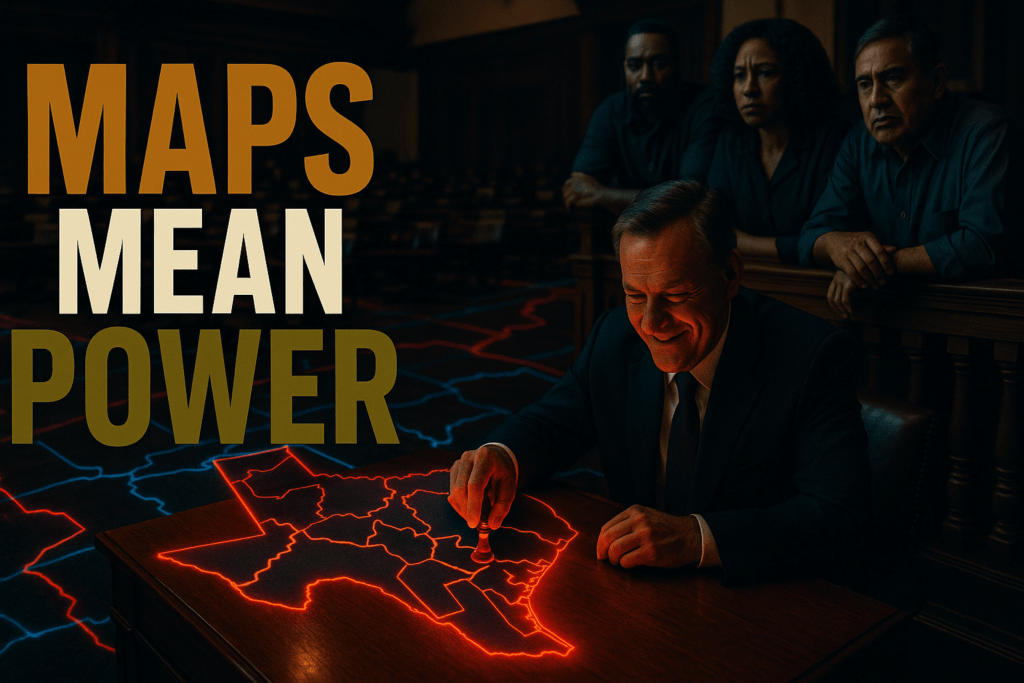

Redistricting: A Political Chess Match
By Darius Spearman (africanelements)
Support African Elements at patreon.com/africanelements and hear recent news in a single playlist. Additionally, you can gain early access to ad-free video content.
Texas Redistricting: A Bold Move
Texas Republicans have started a mid-decade redistricting effort, which is a big deal (newsone.com). This means they are redrawing the lines of voting districts even though it is not the usual time to do so. This move has created five new House seats in areas that voted for President Donald Trump in 2024 (newsone.com). The new electoral map is designed to help state Republicans, making districts held by Democratic Representatives Henry Cuellar and Vicente Gonzalez “redder” and packing Democratic voters into reliably blue districts (newsone.com).
Furthermore, the redistricting effort in Texas has caused other states, like Ohio, to think about reviewing their own electoral maps (newsone.com). The Texas special legislative session, which was supposedly for flood relief, has mostly focused on this new electoral map (newsone.com). This has led to accusations that the Texas GOP used a tragedy for political gain (newsone.com).
Understanding Mid-Decade Redistricting
Mid-decade redistricting means redrawing electoral district boundaries outside the usual ten-year cycle that follows the U.S. Census. This practice is unusual because redistricting typically happens only once every ten years, after the census provides new population data (washingtonpost.com). The state of Texas has only done this once before, in 2003, which was seen as a very unusual and difficult breaking of political rules (texasmonthly.com).
There is no national rule stopping a state from redrawing districts in the middle of the decade for political reasons, such as increasing the power of the party in charge (washingtonpost.com). As one expert noted, “The laws about redistricting just say you have to redistrict after every census. And then some state legislatures got a little clever and said, well it does not say we can not do it more” (washingtonpost.com). However, some states have laws that would make it hard or impossible to do this.
What is Gerrymandering?

Gerrymandering: This is the practice of drawing electoral district boundaries to give one political party an unfair advantage over another (politicaldictionary.com). It can also be used to weaken the voting power of a specific group of people. This often leads to strangely shaped districts that are designed to concentrate opposing voters into a few districts (“packing”) or spread them out thinly across many districts (“cracking”), helping the favored party win more seats (politicaldictionary.com). This practice has been criticized for allowing political parties to manipulate elections for their own benefit, which hurts fair representation and democratic principles (politicaldictionary.com).
The Art of “Redder” Districts and “Packing”
When we talk about making a district “redder,” we mean redrawing its lines to include more Republican-leaning voters (texastribune.org). This makes it more likely that a Republican candidate will win in that district. “Packing” is a gerrymandering trick where voters of the opposing party are put into a few districts (texastribune.org). This makes those districts overwhelmingly winnable for the opposition, but it reduces their power in other districts. This strategy tries to “waste” the opposition’s votes by giving them huge majorities in a few areas, while the favored party wins many more districts with smaller, but sufficient, majorities.
For example, President Trump reportedly wants Texas to do this not because it helps Texans, but because he fears that after the midterms, Democrats will control congressional committees that can investigate his administration (texasmonthly.com). This aggressive redistricting approach would almost certainly lead to legal challenges and concerns that communities of color, who are growing in Texas, would see their voting power reduced (texastribune.org).
A Potential “Tit-for-Tat” Response
The Texas redistricting has started a possible “tit-for-tat” response from states led by Democrats, especially California and New York. New York Democrats have introduced a bill that would allow their state to do mid-decade redistricting if another state did it first (nbcnews.com; yahoo.com). California Governor Gavin Newsom has strongly supported redrawing California’s maps in response to Texas’s actions (texastribune.org; npr.org).
Representatives for Governor Newsom and key House Democrats have been meeting for weeks to talk about possible Democratic responses to Texas’s redistricting plan (texastribune.org). However, while Texas’s redistricting power is with the state legislature, many Democratic-led states have independent commissions (newsone.com; npr.org). This could create constitutional problems for quick map changes.
Independent Redistricting Commissions: A Different Approach
Independent redistricting commissions are non-partisan groups set up in some states to draw electoral district boundaries (politicaldictionary.com). They do this instead of letting state legislatures do it. These commissions are usually made up of citizens who are not elected officials or directly connected to political parties (politicaldictionary.com). Their goal is to reduce partisan gerrymandering and create fairer maps. They are different from legislative-controlled redistricting, where the dominant political party in the state legislature has the power to draw maps that favor their party, often leading to heavily gerrymandered districts.
The existence of such commissions in some states can make it harder to engage in partisan mid-decade redistricting, as they are designed to be protected from political pressure (washingtonpost.com). This means that even if Democratic-led states want to respond to Texas’s actions, they might face legal or procedural hurdles due to these commissions.
Key Redistricting Events
2003 Texas Redistricting
Texas undertook a highly controversial mid-decade redistricting, seen as an extraordinary breaking of political norms (texasmonthly.com).
2024 Presidential Election
Donald Trump won five new House districts in Texas by double digits, influencing the current redistricting efforts (newsone.com).
2025 Texas Special Session
Ostensibly for flood relief, this session primarily focused on creating a new electoral map to benefit Republicans (newsone.com).
New York’s Proposed Bill
New York Democrats unveil a bill allowing mid-decade redistricting if another state initiates it first (nbcnews.com).
California’s Response
Governor Gavin Newsom signals strong support for redrawing California’s maps in retaliation to Texas’s actions (texastribune.org).
Historical Context: Texas in 2003
The 2003 redistricting in Texas was a very controversial and never-before-seen mid-decade redrawing of congressional maps (texasmonthly.com). It was started by then-House Majority Leader Tom DeLay, who wanted to increase the number of Republican seats in the U.S. House of Representatives. This effort was controversial because it happened outside the normal redistricting cycle after a census and was widely seen as an aggressive partisan move (texasmonthly.com).
The 2003 redistricting greatly changed Texas politics by making Republican control stronger in the state’s congressional delegation (texastribune.org). This shift in power had lasting effects on both state and national politics. Its importance lies in showing how mid-decade redistricting can be used to achieve political goals and how it was seen as a “traumatic breaking of political norms” (texasmonthly.com).
Legal Challenges and Their Grounds
Legal challenges to mid-decade redistricting often focus on claims of unconstitutional partisan gerrymandering or racial gerrymandering (washingtonpost.com). While there is no national rule against mid-decade redistricting, courts can find that political lines are unconstitutional if they are drawn to reduce the voting power of minority groups or to unfairly keep one party in power (washingtonpost.com).
For example, the Department of Justice has warned Texas that four majority-minority congressional districts in the Houston and Fort Worth areas are unconstitutionally racially gerrymandered (votebeat.org). This provides a possible legal reason for the state’s current redistricting efforts, even though the state previously said it used a “race-blind process” (votebeat.org). The results of such challenges are uncertain, as courts weigh the state’s right to redraw maps against constitutional protections for voters.
Impact on Voters and Communities
Redistricting greatly affects voters’ representation and communities by shaping the election landscape and potentially reducing the voting power of certain groups. For Hispanic voters in South Texas, an aggressive redistricting approach could lessen their voting power (texastribune.org). This is especially true in districts that have historically been competitive or represented by Democratic incumbents. If districts are redrawn to concentrate Hispanic voters into fewer districts (“packing”) or spread them across many districts where their influence is diluted (“cracking”), their ability to elect candidates of their choice or influence policy outcomes can be severely limited (texastribune.org).
This can lead to elected officials not being as responsive to the needs and concerns of these communities, as their votes become less important. Redistricting this year will likely focus on South Texas, where Democratic Representatives Henry Cuellar of Laredo and Vicente Gonzalez of McAllen won reelection in 2024 by small margins (texastribune.org). Both represent districts centered on the border and are made up of mostly Hispanic populations that shifted to the right in 2024. The GOP hopes these gains will last, but Democrats are trying hard to win them back.
National Implications of Redistricting
The mid-decade redistricting efforts in Texas and potentially other states have big national implications for the balance of power in the U.S. House of Representatives and the overall fairness of federal elections. If successful, these efforts could lead to more seats for the party that started the redistricting, possibly changing who controls the House (texasmonthly.com). This could affect what laws are passed, the ability of congressional committees to oversee government actions, and the overall political situation in Washington D.C.
Such partisan redistricting, especially outside the normal ten-year cycle, raises concerns about election fairness and the honesty of democratic processes. This could lead to more political division and a lack of trust in the election system across the nation. President Trump reportedly wants Texas to do this because he fears that after the midterms, Democrats will control congressional committees that have the power to investigate his administration (texasmonthly.com).
Current House Majority Snapshot
The Flood Relief Session Controversy
It is important to note that while the Texas special session was announced under the idea of flood relief, few of the bills submitted during the pre-file period had anything to do with the recent floods (newsone.com). In addition, we have heard more about this new map than any laws meant to help those affected by the floods. This gives the appearance that the Texas GOP used this terrible tragedy to push their own political agenda (newsone.com).
This situation highlights how political maneuvers can overshadow urgent public needs. The focus on redistricting during a session meant for disaster relief raises questions about transparency and the priorities of elected officials. It also fuels public distrust when political gain appears to take precedence over addressing immediate community suffering.
The Role of President Trump
The Texas redistricting effort came at the request of President Trump, who wants to keep the Republican majority by any means necessary (newsone.com). This shows how influential national political figures can be in state-level decisions that have far-reaching consequences. President Trump’s involvement suggests a coordinated effort to secure Republican power ahead of the 2026 midterms.
This kind of intervention from a national figure in state redistricting is not common. It underscores the high stakes involved in maintaining control of the House. It also points to a strategy that prioritizes political advantage over what some might consider fair democratic processes.
The Race to the Bottom
The fact that we are talking about widespread redistricting in 2025 is very unusual, given that traditional redistricting only happens once every ten years (newsone.com). Currently, the GOP has only a very small majority in the House, with Democrats needing only three seats to take control next year (newsone.com). This apparent race to the bottom is terrible for Americans of all backgrounds. No matter who is doing the gerrymandering, the end result is that a specific group, often Black people, gets their voting rights taken away.
It seems the best way to maintain power is not by implementing policies that are popular and good for the American public, but by rigging maps for political advantage. Efforts like these make it hard to have faith in American democracy. It is no longer about the best ideas and policies winning, but about who can manipulate systems the best. This undermines the very foundation of fair representation and equal participation in the democratic process.
ABOUT THE AUTHOR
Darius Spearman has been a professor of Black Studies at San Diego City College since 2007. He is the author of several books, including Between The Color Lines: A History of African Americans on the California Frontier Through 1890. You can visit Darius online at africanelements.org.
